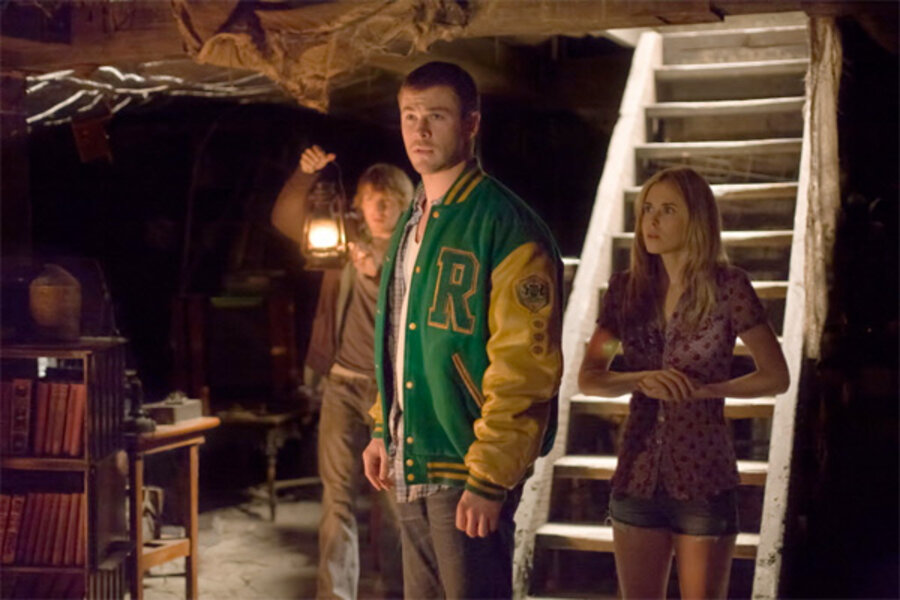'The Cabin in the Woods' is over-the-top, but has an intriguing twist
Loading...
The ups and downs of The Cabin in the Woods release delay had little to do with co-writer and producer Joss Whedon, or writer-turned-director Drew Goddard’s movie; rather, the horror genre hybrid was simply caught in the middle of the MGM Studios collapse. Despite a few big names being attached to the long-withheld project – Avengers star Chris Hemsworth and director Joss Whedon - does The Cabin in the Woods actually offer a fresh and enjoyable horror experience? Or is the film little more than a middle-of-the-road effort that could have easily been left on the shelf?
Much like Eli Craig’s tongue-in-cheek effort, Tucker & Dale vs. Evil, The Cabin in the Woods is far-from a typical horror film. The trailers for the movie spoil one of the most intriguing elements – which not only differentiates the project from regular slasher films, but also gives the writers and cast an opportunity to poke fun at the cliches of the genre without entirely undermining the scares.
In an effort to prevent spoiling the film for others, I’m not going to directly discuss the “twist” or where the filmmakers take the especially ambitious premise; however, I will say that, for readers who are already interested in checking out the film, it’s unlikely that the experience is going to disappoint. The Cabin in the Woods is hardly the most serious, or smartest, horror film audiences will have seen in a while – there are plenty of eye-roll-inducing dialogue moments and the over-arching setup might be hard for some moviegoers to accept – but, for anyone that’s ready for an entertaining (albeit over-the-top) horror movie, avoid the film’s spoiler-filled trailer and head to your favorite cineplex knowing as little as possible.
On the surface level, the story follows five friends Curt (Chris Hemsworth), Holden (Jesse Williams), Jules (Anna Hutchison), Marty (Fran Kranz) and Dana (Kristen Connolly) as they journey up to an isolated cabin for a weekend of drinking, swimming, truth or dare, and other scandalous behavior typically associated with college student getaways. A pre-trip meet up spells out the group dynamics: Dana is the good girl, Curt and Jules play-against stereotype as a hot blond and jock couple that in addition to good looks are also accomplished students, Holden is Curt’s bookish but still charming friend, and Marty is the group’s lovable pot-smoker.
Once on the road, the group encounter an ill-tempered gas pump attendant that, despite his disdain for the college kids, warns the group about their destination – asserting that visitors regularly disappear up in the woods. Dismissing the warnings, the group reach the cabin where, that’s right, things quickly devolve into bloody mayhem.
While many of the proceeding events center around good girl Dana, all of the friends are utilized in interesting ways – especially as the film toys more and more with genre stereotypes. As mentioned, these aren’t the dumb college kids audiences normally see in slasher-type films – and, while the plot can be somewhat convenient at times, there are plenty of interesting twists that arise out of having characters that, despite their basic caricature origins, defy expectation by making different (and, subsequently, more interesting) decisions. Given the difficult task of both embracing and rejecting these horror stereotypes, the cast (which, at the time, included a lot of untested talent) does a surprising job with the more serious moments – coupled with plenty of humorous nods to the audience.
That said, The Cabin in the Woods isn’t just different because it includes smarter versions of typical horror archetypes, the over-arching premise of the film is a game-changer, splitting open the genre format more and more as the film progresses – resulting in a final act that offers some truly enjoyable reveals. Where other filmmakers might attempt to setup the project as the first in a multi-installment franchise, Whedon and Goddard hold nothing back – peeling layer after layer away until they show audiences all that there is to see in The Cabin in the Woods universe. Nearly every recurring piece of mythology, horror, or comedy eventually comes full circle – offering a solid pay-off for moviegoers who can lock into the film’s wild (or absurd), but still satisfying, setup.
While the movie has a lot going for it in the way of an intriguing twist, the “horror” in The Cabin in the Woods might be underwhelming for some die-hards in the genre. There are plenty of tense moments, but many of the surface-level scares will be familiar (and easily anticipated) by a good portion of the audience. This might initially come across as lazy set-piece planning, but as the story plays-out, it’s clear these were intentional choices by Goddard and Whedon – which works to the success (and logic) of the overarching plot.
Ultimately, The Cabin in the Woods is a surprisingly entertaining effort that works because it strikes a smart balance – embracing, as well as rejecting, the viewer’s expectations and knowledge of the horror genre. The set-up is executed with a tongue-in-cheek attitude but presented with a straight face that could be off-putting for viewers who are expecting a straightforward slasher film or a “gritty” and serious scare-fest (such as The Descent or Hostel). However, the final product succeeds in paying homage to the movies that inspired it, poking fun at the often static state of the horror genre, all while simultaneously delivering a few fresh surprises. Anyone willing to suspend a bit of disbelief and not get too bogged down in the film’s logic will likely be ready for an entertaining and worthwhile experience. For many, this trip to The Cabin in the Woods will have definitely been worth the wait.
Ben Kendrick blogs at Screen Rant.





